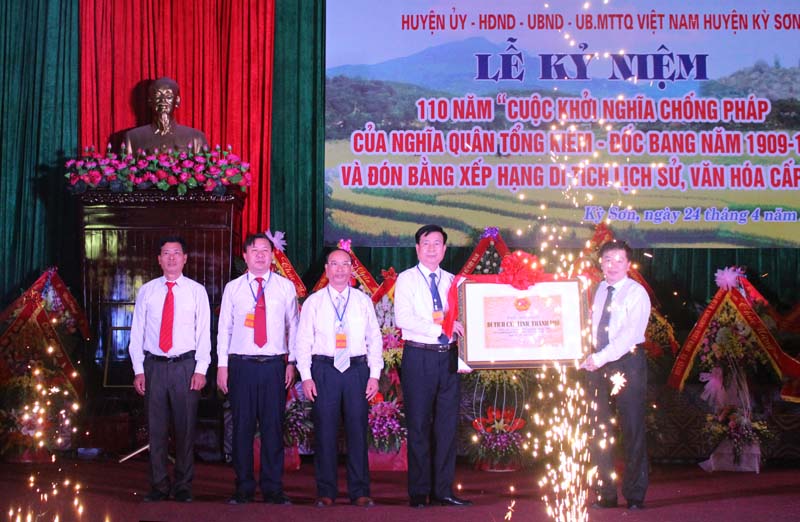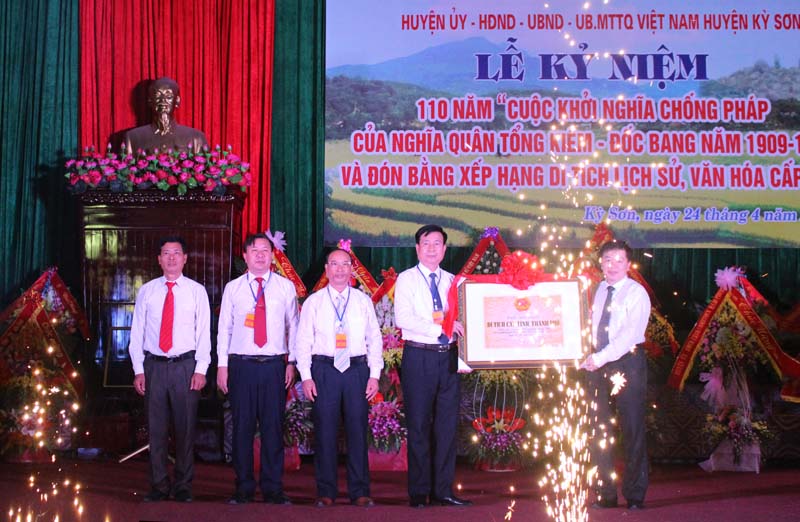
(HBO) - Ky Son district held a ceremony on April 24 to mark 110 years since the uprising against the French colonialists of the Tong Kiem – Doc Bang insurgent troops (1909-1910) and to receive a certificate recognising the base of this uprising as a provincial historical and cultural relic site.
 Vice Chairman of the Hoa Binh provincial People’s Committee
Nguyen Van Chuong presents the provincial historical and cultural relic site certificate
to officials of Ky Son district.
Vice Chairman of the Hoa Binh provincial People’s Committee
Nguyen Van Chuong presents the provincial historical and cultural relic site certificate
to officials of Ky Son district.
The uprising of the Tong Kiem – Doc Bang troops
was the first and only among uprisings against French colonialists of ethnic
people in the northern mountainous region in the late 19th and early 20th
centuries to launch an attack on and successfully occupy the province’s capital.
The uprising, which lasted from April 15, 1909
to January 20, 1910, caused great damage to the administration of French
colonialists in Hoa Binh and forced them to adopt a softer ruling policy in
ethnic minority areas, thus creating favourable conditions for Vietnam to later
build a revolutionary base under the Party’s leadership. Despite being
defeated, the uprising was a milestone in the history of combating foreign
invaders of local residents.
It inherited ancestors’ traditions and inspired
patriotism among the following generations on the path to the August Revolution
that led to Vietnam’s
independence in 1945, as well as Hoa Binh’s feats of arms during the resistance
war against the French colonialists.
The Tong Kiem-Doc Bang uprising’s 110th
anniversary is an occasion to look back on the local patriotic tradition. It is
also a pride of people of different ethnic groups in Ky Son district and Hoa
Binh province.
At the ceremony, officials also announced the
decision of the chairperson of the Hoa Binh provincial People’s Committee to
list the base of the uprising as a provincial historical and cultural relic
site./.
With an increasingly vibrant and widespread emulation movement aimed at building cultured residential areas and cultured families, Yen Thuy District has been making steady progress toward improving both the material and spiritual well-being of its people, while fostering a civilized, prosperous, beautiful, and progressive community.
Once lacking recreational spaces and community facilities, Residential Group 2 in Quynh Lam Ward (Hoa Binh City) has recently received attention for the construction of a new, spacious, and fully equipped cultural house. The project followed the model of state support combined with public contributions in both labor and funding.
The "All people unite to build cultural life" movement, which has been effectively integrated with Kim Boi district’s socio-economic development goals, is fostering a lively spirit of emulation across local residential areas, hamlets, villages, public agencies, and enterprises. In addition, through the initiative, traditional cultural values are being preserved and promoted, while community solidarity and mutual support in poverty reduction and economic development are being strengthened.
A working delegation of the Hoa Binh provincial People’s Committee led by its Permanent Vice Chairman Nguyen Van Toan on June 11 inspected the progress of a project to build the Mo Muong Cultural Heritage Conservation Space linked to tourism services in Hop Phong commune, Cao Phong district.
Born and growing in the heroic land of Muong Dong, Dinh Thi Kieu Dung, a resident in Bo town of Kim Boi district, in her childhood was nurtured by the sweet lullabies of her grandmother and mother. These melodies deeply imprinted on her soul, becoming an inseparable part of her love for her ethnic group's culture. For over 20 years, this love for her hometown has driven Dung to research, collect, and pass down the cultural values of the Muong people to future generations.
In the final days of May, the Ethnic Art Troupe of Hoa Binh Province organized performances to serve the people in remote, mountainous, and particularly disadvantaged areas within the province. These were not just ordinary artistic shows, but they were the meaningful journeys aimed at spreading cultural values, enhancing the spiritual life of the people and contributing to the preservation of ethnic minority cultural identities.



 Vice Chairman of the Hoa Binh provincial People’s Committee
Nguyen Van Chuong presents the provincial historical and cultural relic site certificate
to officials of Ky Son district.
Vice Chairman of the Hoa Binh provincial People’s Committee
Nguyen Van Chuong presents the provincial historical and cultural relic site certificate
to officials of Ky Son district.